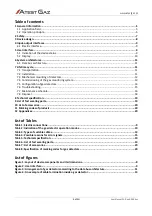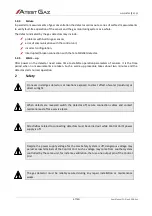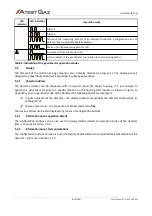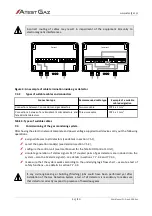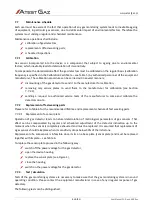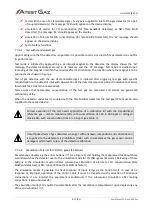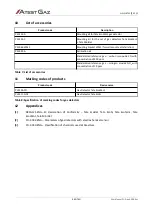
www.atestgaz.pl
Operation of gas detector consists in periodical measurements of hazardous gases in their vicinity with
continuous averaging of measurement results. Momentary concentration of gases are measured with the
time period of 1 second and average concentrations are calculated. These measurements enable reporting
of warnings or alarms.
for CO/NO
2
:
• Alarm 1 or Alarm 2 is raised against the average concentrations of hazardous gases during the
most recent 5 minutes,
• Alarm 3 is reported when the momentary concentration exceeds the threshold limit during the
time period of 1 minute,
for LPG:
• Conditions for Alarm 1 and Alarm 2 are established against average concentration for the most
recent one minute,
• Alarm 3 is generated when any momentary concentration exceeds the threshold limit.
Depending on results of the foregoing actions the system may adopt various statuses that are described in
subsequent paragraphs
1.2.1
Operation
It is the status when the gas detector is in sound working conditions and takes regular measurements.
Measurement results for the monitored gas still remain below threshold limits and no irregularities in
operation of the equipment are detected. The detector needs no particular attention of personnel beside:
regular and frequent verification of indications, preferably under daily basis,
periodical inspection and calibration (see Section 7.7.1).
1.2.2
Alarm 1 (threshold 1) / Alarm 2 (threshold 2)
It is the device status when only slight concentrations of hazardous gases are detected and advising the
personnel is needed.
Under such circumstances the operator should undertake the following actions:
check possible reasons that may include:
• appearing of gas in facilities monitored by the system,
• interference of the detector operation by foreign substances (e.g. solvents of high
concentration or fuel fumes) – such substances must be expelled from monitored facilities,
• offset of the characteristic curve – as the times goes by the detector tend to drift with an offset
of the null point. Therefore detectors must be regularly calibrated, otherwise the alarm
thresholds (for Alarm 1 or Alarm 2) may offset to the area of pure air, i.e. the situation when
competent inspectors have checked by means of appropriate instruments that no gas or
interfering substances are present at the facilities.
1.2.3
Alarm 3 (threshold 3)
This status is adopted when concentration of hazardous gases exceeds the third threshold during the time
period longer than one minute. If so, the necessary actions shall include:
evacuation of third persons from the endangered area,
if possible, enable ventilation of endangered confined spaces, e.g. open windows and doors
(unless the control unit automatically switched the ventilation system on).
s. 6|20
User Manual: POD-046-ENG R01




